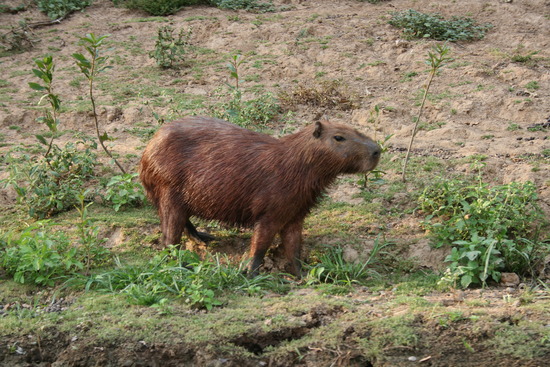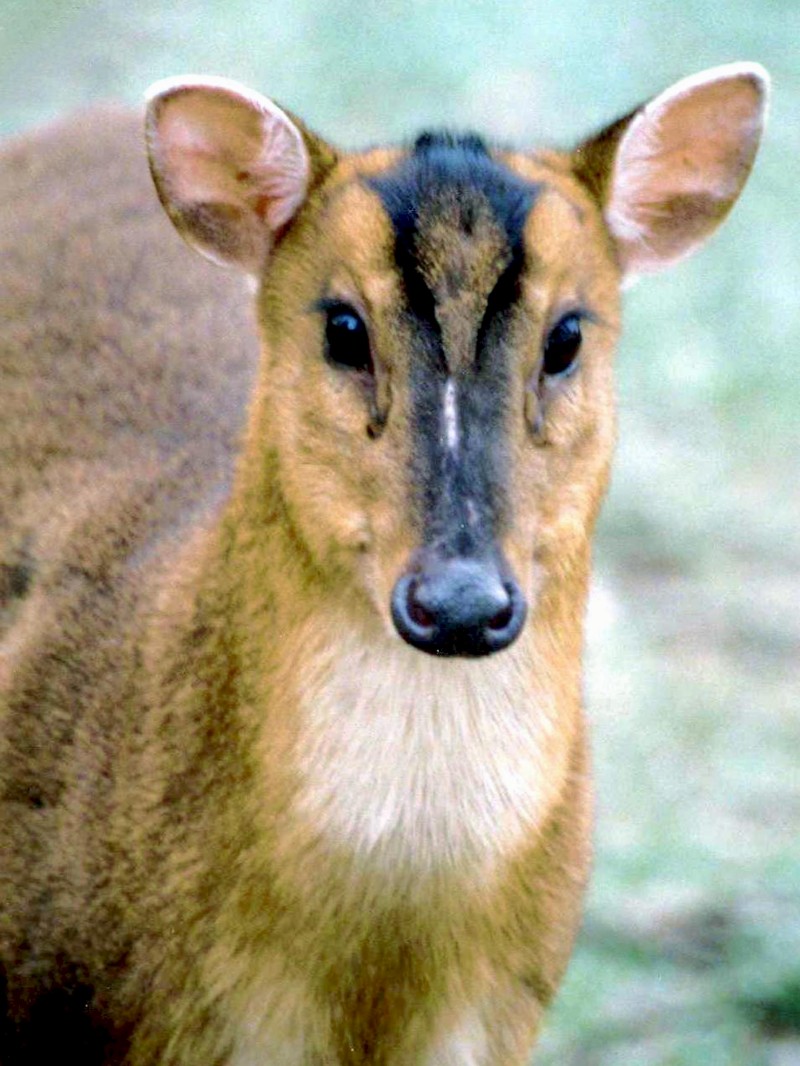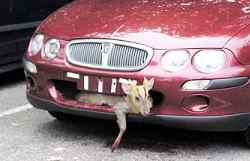Capybara Sightings Continue
Posted by: Loren Coleman on October 13th, 2009
Let us compare the looks of the worldest largest rodent, the capybara to that of the worldest smallest deer, the muntjac deer.
Do you think people are seeing deer and not capybaras? You decide.
Here is the latest on the sightings and the skeptic’s theory.
The mystery surrounding the identity of a large rodent-like creature seen tottering through Totteridge continues as further sightings are being reported.
According to around ten separate witnesses, one or more capybaras are on the loose in the area and hiding in woodland and farmland around the borough.
The 140lb creature, known to be the largest living rodent in the world, is native to South America and very rarely seen in English countryside.
The most recent sighting was made by Dan Mackessy, 43, of Friern Park, North Finchley, who believes he heard two of the creatures beneath his bedroom window a fortnight ago.
He said: “I heard squealing outside, which sounded like a rat or a fox, and when I looked I saw two little brown animals.
“They were definitely not rats or foxes, but as soon as I put my head out, they scampered off behind the flat.
“I think it might have been a couple of capybaras.”
Steve Wells, of Galley Lane, Barnet, believes he and his wife saw a capybara around a month ago.
He said: “I saw what I thought to be a deer about a month ago while driving through Trotters Bottom to Galley Lane.
“It came from the golf course before the A1 junction and disappeared very quickly.
“Then, on Friday, October 2, at around 8.30pm I was returning from St Albans with my wife Mariella when it ran out into the same piece of road, but then quickly ran off.
“After reading about other sightings in the Times Series, we both realised it was in fact a capybara.”
However, naturalist John Colman, 61, of Grange Avenue, North Finchley, believes the alleged capybara is in fact a deer after all.
He said: “The muntjac deer is a very small deer and, incidentally, almost exactly the same size as a capybara.
“They are generally very shy so, although now quite widespread, they are not encountered that often.
“All naturalists know from experience not to dismiss reports of unusual animals or birds out of hand, but I would be very surprised indeed if the majority of these sightings were not attributable to muntjacs.”
Capybaras can grow to 4.5ft long and 1.5ft tall, and weigh from 59lb to 174lb pounds. They have long, coarse, reddish-brown hair, no tail, short limbs, a barrel-shaped body and webbed feet with strong claws.
They are most active at dusk and dawn, and communicate using whistles, whimpers, clicking noises and barks.
What do you think? Have you spotted a capybara scampering across fields near you – or was it merely an overweight deer?
Source, Monday 12th October 2009 by Rebecca Lowe.

Please click on the button below (not the one up top) to take you to PayPal to send in your museum donation.
If you wish to send in your donation via the mails, by way of an international money order or, for the USA, via a check (made out to “International Cryptozoology Museum”) or money order, please use this snail mail address:
Loren Coleman, Director
International Cryptozoology Museum
PO Box 360
Portland, ME 04112
Thank you, and come visit the museum at 661 Congress Street, Portland, Maine 04101, beginning November 1, 2009!!
About Loren Coleman
Loren Coleman is one of the world’s leading cryptozoologists, some say “the” leading living cryptozoologist. Certainly, he is acknowledged as the current living American researcher and writer who has most popularized cryptozoology in the late 20th and early 21st centuries.
Starting his fieldwork and investigations in 1960, after traveling and trekking extensively in pursuit of cryptozoological mysteries, Coleman began writing to share his experiences in 1969. An honorary member of Ivan T. Sanderson’s Society for the Investigation of the Unexplained in the 1970s, Coleman has been bestowed with similar honorary memberships of the North Idaho College Cryptozoology Club in 1983, and in subsequent years, that of the British Columbia Scientific Cryptozoology Club, CryptoSafari International, and other international organizations. He was also a Life Member and Benefactor of the International Society of Cryptozoology (now-defunct).
Loren Coleman’s daily blog, as a member of the Cryptomundo Team, served as an ongoing avenue of communication for the ever-growing body of cryptozoo news from 2005 through 2013. He returned as an infrequent contributor beginning Halloween week of 2015.
Coleman is the founder in 2003, and current director of the International Cryptozoology Museum in Portland, Maine.













Is there a body of water nearby? Capybaras are semi-aquatic animals, so they should look for something resembling their natural habitat.
All capybaras I have ever watched on tv not only live in water, but are brown, like the top photo. In fact, in South America the Catholic church allowed the peasants to eat capybaras on friday (the members of the Catholic faith can’t eat meat on fridays, but can have fish) calling it a fish, officially. The creature in the grill of the car is definitely more deer like. Has the stripes down the snout like the little deer. Hooves like an antelope and the nose looking more like a cow, but small. May not be one pictured above and mentioned, but it is something similar.
While I’m willing to admit that some of these sightings MAY be mistaken identity, I think MOST (not all) people are familiar enough with deer or deer-like creatures to know the difference between that and a large rodent. That actor who saw it and his stepson seemed convinced enough.
I dont know what these good people saw but I know what they probably saw and that is Reeves Muntjac. They are now plentiful in much of the UK. As long as there is a bit of scrub or wood they will take up residence, even in moderate size gardens. They can get used to people and where dogs are not a problem will show themselves. In a built up area they sometimes get their heads stuck in gates.They were originally introduced to the UK at Woburn park which is not far off from the area of the sightings.
They can be noisy, barking and squealing, usually from a concealed position. They breed very rapidly and can be a problem eating out wild flowers such as rare orchids and…getting in the way of cars. They do make good eating however, especially for wild cats and they are interesting even cute!
A smaller probability is that the witnesses have seen the much less common chinese water deer, which can look odd and are more easily mistaken for capybaras. However they like a marshy reedy wet environment as do capybara and I dont think it is available in the area of the sightings.
Interestingly in view of the attention given to possible sasquatch footprints. The first I knew of muntjac being around was, unexpectedly, finding their tiny footprints, either as dimples in the grass or a clear mark in soil. Something for you to look out for in the USA as I read they had been released there and barring predators, the population is likely to explode but as I say, they do make good eating and are ideal prey for wild cats, big or small.
It is my opinion that the animal(s) spotted beneath the window are not capybaras based on the description of the sound. Capybaras do not sound like a rat or a fox. They sound more like birds than anything else. Or guinea pigs but people don’t often make that connection because of the size difference.
Capybaras can live in areas with minimal water if that is there only choice. It is not preferred, but they don’t absolutely have to have a swimming area. Identification of an animal after-the-fact, especially if you did not have a mental image of the species to compare against real-time, is, I think, unreliable. You should hear the ridiculous things Caplin Rous has been called even when people get a good look at him.
If you’d like to hear what capybaras sound like, you can watch the “Caplin Rous Speaks” video on youtube. For more information on capybaras, visit my blog at Giant Hamster.
Interesting to hear the noises made by the Capybaras, chirruping and clicking and a bark. I doubt this is their full repetoire however. The bark was similar to a Muntjac but much shorter. Both a hoarse not a gutteral sound. I have always thought, rather like mutiple uneven lengths of straight lines of sound being projected to you at the same time.
The Muntajc alarm call can be very loud and if one is unware of it frightening, echoing around a quiet wood, mostly at night. It can be, not suprisingly heard a long way away. The squealing can be loud as well but is heard less frequently and seems to be more to do with disputes or mating.
Personally I have not heard of capybaras roaming in the UK nor have
gamekeepers of my aquaintence. There are wild boar now and this could lead to misidentification.